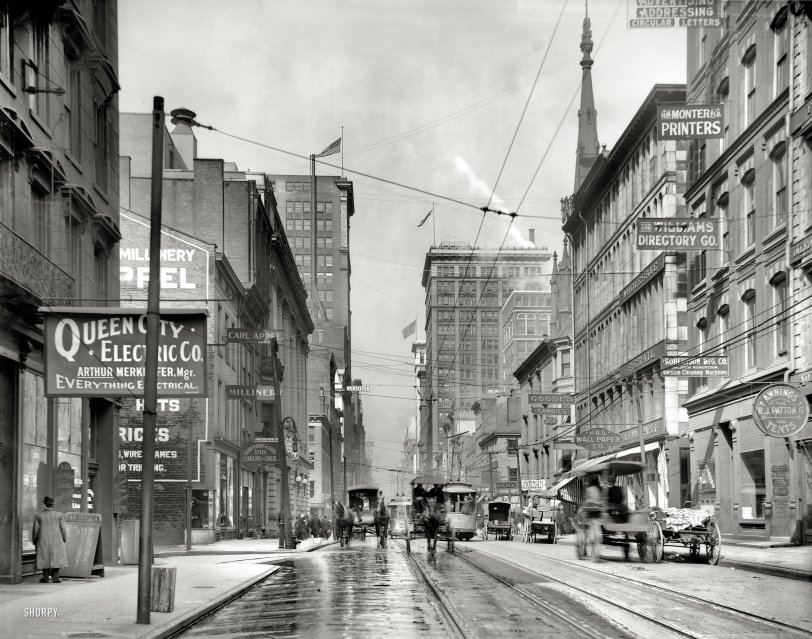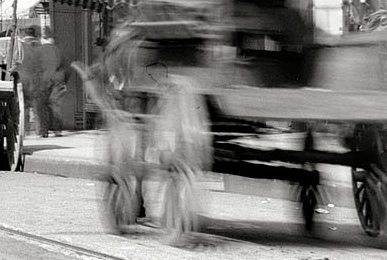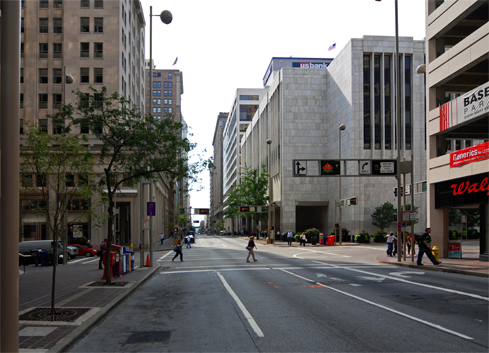


Framed or unframed, desk size to sofa size, printed by us in Arizona and Alabama since 2007. Explore now.
Shorpy is funded by you. Patreon contributors get an ad-free experience.
Learn more.

- Baldwin 62303
- Baldwin VO-1000
- Cold
- No expense spared
- Tough Guys
- Lost in Toyland
- And without gloves
- If I were a blindfolded time traveler
- Smoke Consumer Also Cooks
- Oh that stove!
- Possibly still there?
- What?!?
- $100 Reward
- Freeze Frame
- Texas Flyer wanted
- Just a Year Too Soon
- WWII -- Replacing men with women at the railroad crossing.
- Yes, Icing
- You kids drive me nuts!
- NOT An Easy Job
- I wonder
- Just add window boxes
- Icing Platform?
- Indiana Harbor Belt abides
- Freezing haze
- Corrections (for those who care)
- C&NW at Nelson
- Fallen Flags
- A dangerous job made worse
- Water Stop
Print Emporium
Ostrich Feathers Curled: 1910

Circa 1910. "Fourth Street, Cincinnati, Ohio." Home to merchants trading in a variety of goods and services, the most esoteric of which might be "Ostrich Feathers & Boas, Cleaned, Dyed and Curled." 8x10 glass plate. View full size.
Ah Yes, I Remember it Well
Downtown Cincy was full of color and life, back in the mid-70's, when I was tootling around there. I remember being very disappointed when so many of the buildings around Fountain Square were razed for some grey hotel and a tower. It hemmed in the square, took away its contours, and ruined the scale. Cities should always be viewed as a whole, not simply as fodder for opportunistic investment. Thus, the contemporary picture of Fourth Street could be nearly anywhere now.
The current city pop is around 296,943, down from well over 500,000 in the 50's.
Of rails and horse carts
The Snopes folks have a very good page on this topic: www.snopes.com/history/american/gauge.asp
The Second Queen City
Charlotte, NC is second only to Cincinnati among Queen Cities, with a population of approx. 1,700,000, compared to Cincy's 2,100,000. Charlotte got its nickname the honest way, in honor of Charlotte of Mecklenburg-Strelitz, the Queen consort of King George III. Don't think it has any interesting trolley facts in its past, though.
Double overhead wires
I recently drove through Dayton, Ohio and they still have some double overhead wires installed. If they are still there then I am guessing that they still have the trolly buses that use them.
Cincinnati switched from trolly cars to trolly buses when I was a kid (in the 50s) but they used the already existing overhead wires. I can barely remember riding on the old streetcar system but I have a lot of time logged riding in the trolly buses.
Queen cities of the U. S.
I've lived in at least two other "Queen Cities" in the U. S. over my long life. That name was assigned to my home town, Newburgh, New York, by the city fathers back at the end of the 19th Century, and I lived for a few years back in the 1960's in Plainfield, New Jersey, which the local Chamber of Commerce also called "The Queen City". I'm sure there are many more of them, too.
Double trolley wires no folly
Single overhead wires used the earth for a return path, which caused severe electrolysis in conductive things the current passed through on its way back to its source. Cincinnati avoided all such damage by prohibiting single overhead feeds.
The Cincinnati Street Railway used a very broad track guage gauge intentionally, I read somewhere, to prevent standard-gauge railways from entering the city: with unusuable tracks, no railroad would attempt political tactics to gain trackage rights!
Overhead wires!
Note the double overhead trolley wire for which Cincinnati was well known right up until the end of trolley service. In the early days certain lines in Washington DC had double wire. I can't think of anywhere else off the top of my head.
Behold a one-legged horse
Glocke380: One hind leg of the horse pulling the cart on the right is visible.

Trolley vs Railroad Gauge
> by Larmo: example of wagons and standard gauge rail having the same width or "gauge" of 4 feet 8½ inches. <
It also shows that Cincinnati city trolleys didn't use standard railroad gauge, the standard gauge wagon seems to have trouble getting the wheels on our left in the groove of the 5 foot, 2-1/2 inch trolley tracks! Standard gauge Cincinnati & Lake Erie RR trolleys from Detroit, Mich., are still waiting for the subway to be completed, so they can run farther into the city than Winton Place. Cincinnati, Newport & Covington trolleys from Kentucky used the wider gauge, and did run across the suspension bridge into Dixie Terminal.
Notice the conductor on Avondale trolley 1701 holding the ropes so he can shift the poles to the right turn wires. That double trolley wire was so complicated that they didn't always have switches in it, until conductors got more expensive.
Tough Job
I wouldn't want to be the guy that has to hold the ostrich down. I believe they're one of your bigger stronger birds, and they probably don't like it.
Where is the horse?
That wagon on the right side is moving fast, where is the horse? Is the horse moving so much that the camera didn't capture it? It might be an early Studebaker, not sure.
Building identity
The one on the left, with the large columns.
Boa's
Misuse of the apostrophe is apparently not a recent development.
Same Gauge
Another wonderful photo and example of wagons and standard gauge rail having the same width or "gauge" of 4 feet 8½ inches. Early railroads began with wooden rail and horses pulling carts and trolleys made from wagons using existing materials. Standard gauge railroads grew from this wheel width and continue to this day. Wagons continued to use the same gauge as existing wagon ruts were everywhere and it was easier to run in the same ruts than attempt to travel half in and half out. Early automobiles, such as Ford's Model T, also had the same gauge to travel in the ruts made by the wagons before them. Apparently this all began as construction convenience for Roman chariots being built to fit behind two horses.
+98
Below is the same view (west on Fourth Street from Main Street) from August of 2008.

























On Shorpy:
Today’s Top 5